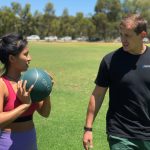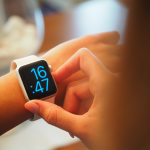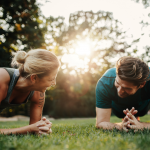**Disclaimer: None of these tips are claims that any food can prevent or cure COVID-19, or any other such virus. Please continue to follow the WHO, CDC and government regulations for current recommendations including hand hygiene, social distancing, etc.**
Undoubtedly so, COVID-19 has taken a toll on many of our lives. It has affected things such as our work and social lives, our economies, and for many, our general sense of wellbeing. While this time is chaotic and unpredictable, continuing healthy habits can help you track along with your health goals and maintain your wellbeing.
Here are some tips to help you with your healthy eating journey:
Eat a varied and balanced diet
Just like any other time, eating plenty of fruits and vegetable, wholegrains and cereals, low-fat dairy products, lean meat and alternatives, and limiting intake of foods high in saturated fats and sugar is recommended to keep your body and immunity well-functioning and strong.

Manage portions and over-eating
Many of us (myself included) find it difficult not to snack when there is 24/7 access to your fridge and pantry. This is the case for many people working from home at the moment. If you are concerned about this, you can try:
- Planning out your meals and snacks like you would on a regular day
- Listen to your body and eat mindfully. Think about whether you are actually hungry or if there is something else going on (stress, boredom, etc.).
- Eat slowly, and take time to enjoy the food you are eating
- Have healthy snacks available to avoid over-indulging in less nutritious options. Some options are fruits, veggie sticks, hummus, low-fat cheese, wholegrain crackers, muesli and yoghurt, boiled eggs, etc.
- Following the Australia Guide to Healthy Eating guidelines for recommendations of serving sizes for different foods: https://www.eatforhealth.gov.au/food-essentials/how-much-do-we-need-each-day/recommended-number-serves-adults
Follow food safety guidelines
When making food at home, it is important to follow good hygiene practices to avoid getting foodborne illnesses, especially at this time. According to the World Health Organization, these 5 tips are recommended:
1. Keep your hands, kitchen and utensils clean1
2. Separate raw and cooked food, especially raw meat and fresh produce1
3. Cook your food thoroughly1
4. Keep your food at safe temperatures, either below 5 °C or above 60 °C1
5. Use safe water and raw material1
Adjust your grocery shopping and organize your pantry/fridge
Consider what you already have at home that you can make meals and snacks with (good time for pantry organization!). Plan ahead by using a grocery list to avoid spending too much time in the grocery stores. Please only buy what you need and avoid panic-buying, as these behaviours can cause increased food prices1, overconsumption of food1, and leaving others without the necessary foods/items.
If your regular foods are unavailable, make swaps
Some foods have been difficult to access such as pasta, rice, meats, etc. due to panic-buying and demand/supply changes. If this is the case, some good swaps can be: wholegrain bread/wraps, lentil/rice-based pasta, rice noodles, bulgur, barley, quinoa and other such wholegrains.
The prices of fresh produce have also gone up, as much as threefold in some places. If you are struggling with this, or simply want more convenience, fresh fruits and veggies can be swapped with frozen/canned options – providing equal nutritional benefits. Aim for lower salt and sugar options in these foods, such as syrup-free canned fruit, or draining the juices in canned products.
Try new recipes and experiment with food
Many of us may be working from home at this time, and may have more time than we usually do to focus on food preparation. This is a great opportunity to try those recipes you have always wanted to try and experiment with different foods (fresh banana bread anyone?)
Often, involving the people you live with in this process (families, children, roommates, etc.) can be a fun way to bond and connect.
Some delicious and nutritious recipes can be found at:
https://daa.asn.au/smart-eating-for-you/smart-eating-recipes/
https://www.eatforhealth.gov.au/eating-well/healthy-recipes
https://www.healthier.qld.gov.au/food/recipes/
https://www.betterhealth.vic.gov.au/healthyliving/recipes
https://www.makehealthynormal.nsw.gov.au/food/healthy-recipes
Limit alcohol intake and stay hydrated
Being at home, feeling stressed, being bored, and many other reasons during this time can lead to increased alcohol intake. Alcohol intake is associated with many short-term and long-term health risks such as:
- excess weight gain
- immune system depression
- injuries
- liver problems
- cancer
- high-blood pressure
- heart conditions
- depression, anxiety, fear, panic
- interactions with medications
and many others..
Healthy Adults: Limit alcohol intake to the recommended intake of no more than 10 standard drinks per week, and 4 drinks on one occasion
Pregnant/Breastfeeding Women: Not drinking is the safest option
For more info on standard drinks visit: https://www.health.gov.au/health-topics/alcohol/about-alcohol/standard-drinks-guide#what-are-standard-drinks
If you are seeking help with alcohol reduction, call the National Alcohol and Other Drug Hotline (1 800 250 015)
The healthiest beverage option is water. Limit excessive intake of caffeinated or sugary drinks such as energy drinks, juices, soft-drinks, sports drinks, etc. These can not only lead to dehydration, but also adversely affect your quality of sleep.
This can be a great time to experiment with new foods, start practicing healthier eating habits, and kick-start your health journey. However, be mindful that your normal eating pattern may change during this time. If you have any concerns about your nutrition, as always, please reach out to a qualified nutrition expert for recommendations (like your friendly neighbourhood dietitian ☺).
Wishing you all health, safety and calm during this time.
Author: Nishaat Patel (Accredited Practising Dietitian)
References
1) World Health Organization. Food and nutrition tips during self-quarantine [Internet]. Europe [cited 2020 May 03]. Available from: http://www.euro.who.int/en/health-topics/health-emergencies/coronavirus-covid-19/novel-coronavirus-2019-ncov-technical-guidance/food-and-nutrition-tips-during-self-quarantine
2) Australian Government. Australian Guide to Healthy Eating. [Internet]. Australia [updated 2017 Jan 05; cited 2020 May 03]. Available from: https://www.eatforhealth.gov.au/guidelines/australian-guide-healthy-eating
3) Images sourced from: https://unsplash.com/






